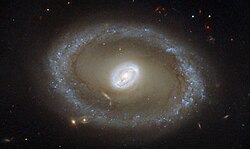| NGC 3081 | |
|---|---|
 NGC 3081 by Hubble Space Telescope | |
| Observation data (J2000 epoch) | |
| Constellation | Hydra |
| Right ascension | 09h 59m 29.5s[1] |
| Declination | −22° 49′ 35″[1] |
| Redshift | 0.007976 ± 0.000010[1] |
| Heliocentric radial velocity | 2,391 ± 3 km/s[1] |
| Distance | 83 Mly (25.3 Mpc)[1] |
| Apparent magnitude (V) | 13.5 |
| Characteristics | |
| Type | (R_1)SAB(r)0/a[1] |
| Apparent size (V) | 2.1′ × 1.6′[1] |
| Notable features | Seyfert galaxy |
| Other designations | |
| IC 2529, ESO 499-G31, AM 0957-223, MCG -04-24-012, PGC 28876[1] | |
Preview warning: Page using Template:Infobox galaxy with unknown parameter "credit"
NGC 3081 is a barred lenticular ring galaxy in the constellation of Hydra. NGC 3081 is located about 85 million light-years away from Earth, which means, given its apparent dimensions, that NGC 3081 is approximately 60,000 light-years across. It is a type II Seyfert galaxy, characterised by its bright nucleus. It was discovered by William Herschel on 21 December 1786.
NGC 3081 is seen nearly face-on. The galaxy's barred spiral centre is surrounded by a bright loop known as a resonance ring. This ring is full of bright clusters and bursts of new star formation, and frames the supermassive black hole thought to be lurking within NGC 3081—which glows brightly as it gobbles up infalling material.[2]